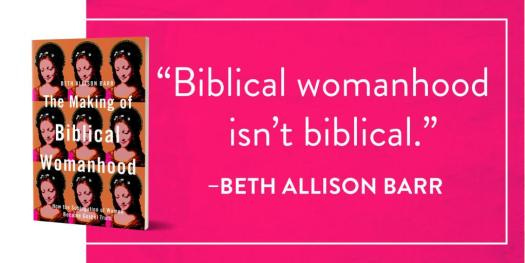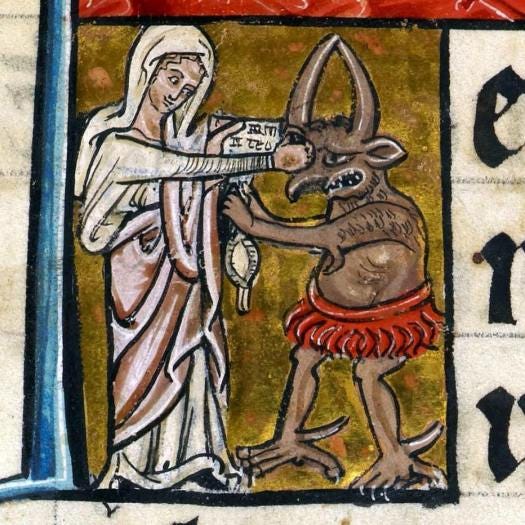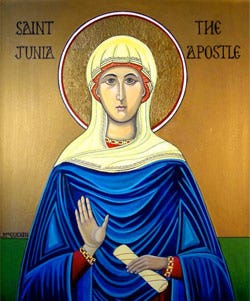Review of The Making of Biblical Womanhood by Beth Allison Barr
Part I: Here’s What’s In This Book
Historian Beth Allison Barr’s The Making of Biblical Womanhood: How the Subjugation of Women Became Gospel Truth is one of a bevy of new books attempting to deconstruct (white) patriarchy in American evangelicalism hot on the heels of the #metoo movement and anti-racism protests of 2020. As an evangelical Baptist with a high view of Scripture, Barr grew up in the world of biblical womanhood. In contrast, neither of us grew up with complementarianism, although as adults we have become more conscious of the gendered ideals of “biblical womanhood” promoted within our own corner of Christianity.
The categories of complementarian and egalitarian are often assumed to be the only two interpretive lenses available when considering of the role of women in the church: denominations that ordain women are “egalitarian” and those that do not are “complementarian.” However, these categories do not simply address whether or not women may be pastors, or if men and women are interchangeable. Complementarianism packages the distinctions between men and women into a broader cultural and social hierarchy—biblical man/womanhood—governing gendered roles in church, family, and society. Barr’s experiences with complementarianism, including biblical womanhood, clashed with her scholarly training, causing her to wonder, is biblical womanhood actually biblical? Did God ordain patriarchy? Does Jesus want women to live in “complementary” marriages under male headship? Eventually, the “evidence” showed her “how Christian patriarchy was built, stone by stone, throughout the centuries, [and as a result] arguments for women’s subordination reflect historical circumstances more than the face of God.”1 As an historian and a youth pastor’s wife, Barr is now on a mission to get the word out that biblical womanhood is far from biblical.2

Barr begins by discussing the historical origins of patriarchy, which she equates with complementarianism, in the rise of agricultural societies. The historical origin of patriarchy makes it a feature of the post-fall world, not an original part of creation, which leads her to ask “What if patriarchy isn’t divinely ordained but is the result of human sin?”3 This seems a dangerous and difficult question, but she carefully demonstrates that patriarchy, far from being particular to Christianity, is actually the norm across cultures, continents, and millennia. What if patriarchy is actually the result of the church copying the culture rather than standing distinctly set apart from it? Barr goes on to note that complementarianism is not only based on the creation account in Genesis, but also on Paul’s teaching in 1 Corinthians and 1 Timothy.4
One might expect that a book of this sort would tread quite lightly around St. Paul, fearing that his letters might ruin the entire project, but that is not the case here. Rather than avoiding Paul, the book devotes an entire chapter to him to demonstrate that he is not as foundational to modern notions of biblical womanhood as is often imagined. Barr begins by suggesting that “Evangelicals read Pauline texts as designating permanent and divinely ordained role distinctions between sexes. Men wield authority that women cannot.”5 However, Barr argues that complementarians have been reading these texts through the “lens of modern culture” and as a result have masked the intended message of radical unity in Christ.6
For example, at first glance, the Pauline household codes read just as one would expect of the first century Roman world, which Barr is quick to acknowledge. However, she also points to their incongruity with the Roman world in how they directly address women, children, and slaves, instead of just the head of household.7 Moreover, Paul calls on husbands to love their wives “as their own bodies.”8 This, she suggests, represents a broader resistance to the Roman patriarchal order than is often assumed by many readers. She is, of course, correct to underscore that Paul is not interested in strictly replicating or codifying Roman hierarchies and civil realities within the church. Such a hierarchy would make it impossible for Christians to recognize each other as brothers and sisters united in Christ across all class, gender, and racial differences. Paul’s recognition of women, children, and slaves as Christians who are equal members of the body of Christ, yet remain Romans, is representative of a quiet subversiveness we see throughout the epistles. For Barr, Paul called Christian families to be radically different than patriarchal Roman families.
Moreover, she argues that rather than teaching women ought to be silent in all public settings, 1 Corinthians 14:33-35 actually describes a typical Roman practice for Christians to avoid. The following verses (36-40), as is made clearer in the Revised Standard Version translation, reject the Roman model and instead call for women’s equality. But, even if this is not the correct reading of 1 Corinthians 14,9 Barr argues that Paul can’t intend for his prohibition on women’s speech in the church to be universally binding because he lists several women, especially Phoebe the deacon and Junia the apostle, in prominent leadership roles. Unfortunately, we’ve misread Paul and slipped back into the patriarchal model from which he sought to free women.
To further underscore this point about our modern usage of Paul, Barr points to her research on late-medieval English wedding sermons, which, though full of Scripture, rarely use the Pauline household codes for their text. They instead emphasize unity through marriage over hierarchy within marriage. To be clear, Barr is not arguing that the medieval era was somehow egalitarian (it wasn’t), but rather that despite how patriarchal late-medieval England most assuredly was, medieval preachers still did not emphasize the household codes to the same degree as modern evangelical complementarians. Barr then goes on to discuss the authority of medieval women in the Latin Church. She notes that the historical and legendary female saints so popular among the medievals have largely been forgotten, since they did not fit the procrustean bed of modern “biblical womanhood.”

Significant female mystics and leaders of the medieval Church like Margery Kempe and Hildegard of Bingen have been written out of the historical record of evangelical Christianity because of the (erroneous, according to Barr) assumption that women “can’t preach.” In addition to surveying Christian women of the medieval period, she also examines some of the women who were revered as part of the medieval devotional life. Many of these women eschewed marriage and children in favor of what they saw as a higher calling. Here she quite usefully contrasts the modern and medieval views of Mary and Martha of Luke 10. There are many modern books written for a female audience that elevate Martha as a homemaker. Yet, the Western medieval tradition surrounding these two women maintained that Mary of Bethany was Mary Magdalen, who was not only a former demoniac but also a prostitute, and went on to be the disciple who preached the resurrection to the apostles. Furthermore, the medieval tradition maintained that Mary later became a missionary who preached the gospel in France. Her unmarried sister Martha—no slouch herself—accompanied her and slew a dragon on a French beach.10 Of course, there is no historical evidence to lend credibility to this tradition, but that is hardly the point. Barr’s broader point is that in the pious imaginations of the medieval world, no one thought it necessary to restrict Mary and Martha to the domestic sphere. Rather they cast them as single female missionary dragon slayers.

Moving on, Barr agrees with historian Lyndal Roper that rather than liberating women, the Protestant Reformation limited their spiritual authority and options outside the home.11 Although Paul’s household codes were well known in the Middle Ages, “…it wasn’t until the Reformation era that they begin to be used systematically to keep women out of leadership roles.”12 Indeed, biblical womanhood as we think of it today derives in large part from the renewed emphasis on women as wives and mothers during the 1500s.13 In short, the Reformation replaced the authority of male priests with the authority of husbands.
Barr then moves into a discussion of English-language translations of the Bible. As a medievalist, she is keen to note that English-language translations existed prior to the Protestant Reformation and that laity were often quite familiar with the biblical text. She also points out that prior to the early-modern period, and the advent of feminism, “gender inclusive” language was common in translations and sermons as preachers sought to include women.14 Early-modern print translations, however, used “falsely universal language” to intentionally or unintentionally write women out of the leadership in the church.15 According to Barr, this problem persists with the English Standard Version of the Bible, which—like all translations—was influenced by the ideologies of its translators. In this case, the ideology was complementarianism and the result was that modern patriarchy wound up erasing women in a Bible translation popular among evangelicals.
Barr goes on to discuss the divinization of the modern cult of domesticity after the Enlightenment. Following the Reformation, women could no longer achieve spiritual authority through virginity. Instead, becoming a wife and mother became the spiritual ideal for women as domestic life replaced monastic living as the vessel of sanctification. One result of this phenomenon was that women’s “subordination became embedded in the heart of evangelical faith.”16 Alternatively, as Barr also puts it, Protestants sanctified the cult of domesticity. Contrary to evangelical misconceptions, the cult of domesticity does not have biblical origins. Rather, it developed out of the Reformation’s elevation of women as wives and the Enlightenment insistence that women were a naturally weaker and passive sex that ought to be confined to the safety of the private sphere. The Industrial Revolution only further cemented the division between the emerging public and private spheres and contributed to the development of the domestic ideal among middle-class women. In short, what we think of today as biblical womanhood is really a warmed-over version of the post nineteenth-century cult of domesticity, which has its roots much more firmly in Enlightenment philosophy, pseudo-science, and industrialization than in sound biblical exegesis.
Barr then reveals that the history of evangelicalism has been replete with examples of women preaching and serving in other leadership positions. She argues that evangelicals have forgotten their own past, which has enabled women’s subjugation and “biblical womanhood” to become “Gospel truth.”17 In order to further solidify “biblical womanhood” as “Gospel truth,” Barr argues that evangelicals turned to the doctrine of the inerrancy of Scripture and even the “Arian” heresy of the Son’s eternal subordination to the Father. Inscribing women’s subordination in the inerrant Word of God and into God’s very essence itself made “biblical womanhood” fundamental to the evangelical Gospel. Barr insists, however, that this is a false Gospel. Jesus set women free and regarded them as equals to men. As a result, fidelity to Jesus entails rejection of the subordination of women inherent in biblical womanhood.
Stay tuned for our critique in Part II…

[1] Beth Allison Barr, The Making of Biblical Womanhood: How the Subjugation of Women Became Gospel Truth (Grand Rapids: Brazos Press, 2021), 205.
[2] Barr, The Making of Biblical Womanhood, 9.
[3] Barr, The Making of Biblical Womanhood, 25.
[4] Note that we’re hyperlinking to the ESV translation since that’s the translation favored by The Lutheran Church–Missouri Synod and critiqued by Barr. But you might want to play around with the translations of the different linked verses. For example, compare 1 Timothy 3 in the ESV and the CEB versions. Or you might try comparing the English translations to the NA28 Novum Testamentum Graece text.
[5] Barr, The Making of Biblical Womanhood, 40.
[6] Barr, The Making of Biblical Womanhood, 41.
[7] Barr, The Making of Biblical Womanhood, 49.
[8] Eph 5:28 ESV
[9] See Gregory J. Lockwood, 1 Corinthians, Concordia Commentary (St. Louis, MO: Concordia Publishing House, 2000), 503-544 for another perspective.
[10] Barr, The Making of Biblical Womanhood, 82-83.
[11] See Lyndal Roper, The Holy Household: Women and Morals in Reformation Augsburg (Oxford: Oxford University Press, 1991).
[12] Barr, The Making of Biblical Womanhood, 127.
[13] Barr, The Making of Biblical Womanhood, 106.
[14] Barr, The Making of Biblical Womanhood, 139.
[15] Barr, The Making of Biblical Womanhood, 150.
[16] Barr, The Making of Biblical Womanhood, 154.
[17] Barr, The Making of Biblical Womanhood, 186.
The Making of Biblical Womanhood: How the Subjugation of Women Became Gospel Truth. By Beth Allison Barr. (Grand Rapids: Brazos Press, 2021, Pp. 256. $19.99, paperback.)
Image of St. Junia from http://evangelicaltextualcriticism.blogspot.com/2018/02/suppressing-female-apostle.html.
Re-posted with permission from the blog Jack Kilcrease: Crux sola est nostra theologia, originally posted May 1, 2021.





